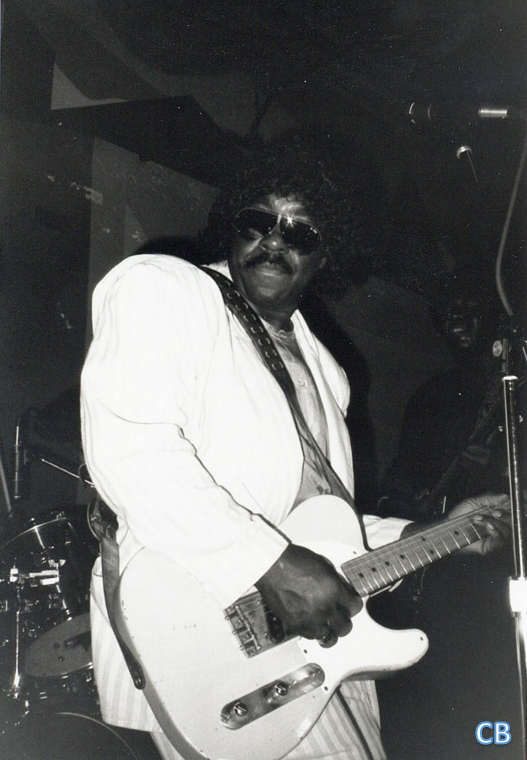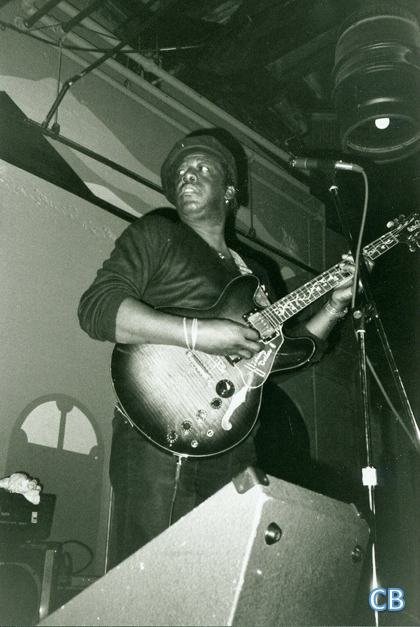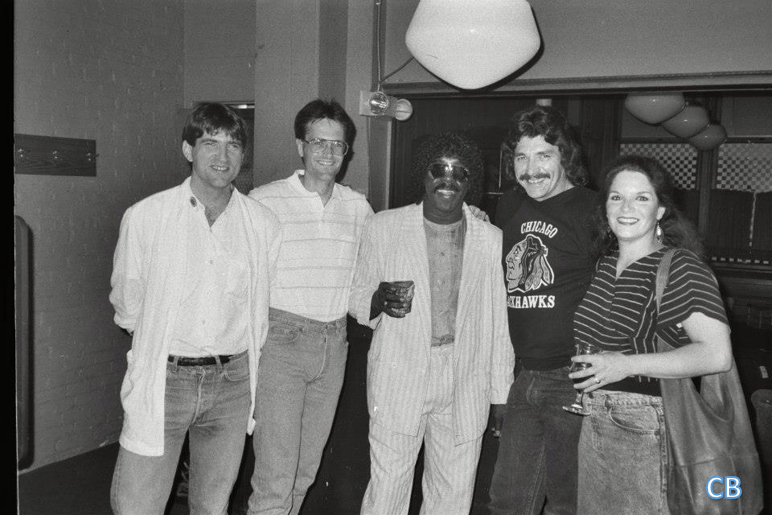Phil Guy – A Forceful, Urban Bluesman Who Stood Highly Upon His Own Compelling Merits
Anticipation was running high in the Mishawaka, Indiana blues community in the late 1980s as Phil Guy was scheduled to bring his blues show to the Center Street Blues Café. Being only 95 miles east of Chicago, the club enjoyed a strong roster of the Chicago greats regularly playing the venue, while also hosting national touring acts, as well as local and regional bands, as well.
We all knew about Buddy Guy and his stature back then even before awareness of him broke on a much wider basis following his first Silvertone label release. To many of us, Buddy was a blues guitar god, and his 1970s and 1980s presence in the area and Chicago clubs, and on packaged shows in the region, allowed us all a glimpse into his blues guitar mania. For many of us, seeing him perform was as close as any of us would get to a Jimi Hendrix experience (though we were acutely aware of Buddy’s impact on a young Hendrix).
Of course, we were also aware of Phil and his strong reputation in blues circles, but he was more of a mystery to us. We never made pilgrimages to catch his shows, and aside from seeing him sitting in with someone at one of Chicago’s south side clubs, none of us ever had the opportunity to fully appreciate his act over the course of an entire evening.
Well, Phil and his band rolled into Center Street, and for the next three hours or so we were indoctrinated into the strong, edgy, and funkier brand of blues that Phil brought to the table. With Chicago blues guitarist and singer Johnny Dollar as a main component in his tough, tight band, Phil took all of his “to church,” as they say, with his unrelenting drive, the loud, piercing, scrunching tones coming from his blonde-colored Fender Telecaster, his assured, street-wise demeanor and vocals, and conversely cool image resulting from his immaculate white suit of clothes. We were all immediate Phil Guy converts.
As I’ve not written a brief profile on Phil Guy, now’s the time while the memories from that astounding performance almost forty years ago are fresh in my mind.
Phil was born in Lettsworth, Louisiana in late April, 1940, an unincorporated area in the northernmost expanse of Pointe Coupee Parish. It was never a largely populated area, and that is indicated as recently as the 2005 census when Lettsworth was said to have 202 residents. Phil was the third male child born to parents who worked as sharecroppers.
Like may, Phil found his introduction to music by the sounds he was hearing coming from Nashville, Tennessee’s WLAC, a station with the power of 50,000 watts (so it carried deep into the south), one that highly featured blues and R&B. He was immediately hooked on the music.
As Buddy was also strongly drawn to the same sounds coming from their radio, both he and Phil were driven to attempt to learn and play the guitar sounds they most enjoyed that came from swamp blues greats such as Lightnin’ Slim, certainly Slim Harpo, and many of the others who went on to be giants for the famed Excello label.
When Buddy finally decided to set out from Lettsworth for Chicago, Illinois in 1958, the 18-year-old Phil felt the pull of trying to replace his brother’s presence in the Baton Rouge, Louisiana (61 miles southeast of Lettsworth) bands he was performing with, groups led by the likes of Baton Rouge blues patriarch Raful Neal, and with lesser-known artists such as a man whose stage name was Big Poppa. In fact, Phil stayed with Neal for over a decade, plying his guitar trade and learning all he could on the bandstand.
The year 1969 was a major one for Phil. After serving his blues apprenticeship on the Baton Rouge blues scene, as Buddy’s star was beginning to rise in Chicago, Phill was summoned to the big city by his older brother. The request to reunite with his sibling and be an integral part of his band proved too powerful a request to turn down, so like Buddy before him, Phil moved north.
Like any major move, there were acclimations to be made, especially in a major metropolitan northern U.S. city, but Buddy having established himself there over a decade prior aided Phil in the transition. In addition to working in Buddy’s band, Phil and Buddy also extensively collaborated with blues harmonica giant Junior Wells on many shows and tours. Phil was obviously used to playing with a blues harmonica player due to his long stint with Neal, so the time with Wells didn’t suffer for a lack of experience with a harmonica artist.
Phil’s guitar style was, in many ways, the antithesis of Buddy’s. He was not flamboyantly driven. But he was dynamically and musically very sound, and in short order he came to enjoy a valued reputation as an unfailingly dependable sideman. Through the 1970s (in this writer’s estimation one of the greatest eras of Chicago blues), Phil was in great demand, and he benefitted from the ability to work with many blues artists including the aforementioned Junior Wells, west side guitar man Jimmy Dawkins, and “The Queen Of The Blues” Koko Taylor.
But all the while it was obvious that Phil was trying his hardest to make his own position in the blues world rise. No doubt there was a more than a shred of wanting to be a fully capable and recognized bluesman like his older brother Buddy. As such, Phil wanted to see his work memorialized on a recording. Phil realized that opportunity in 1981 when he and Buddy produced a four-song LP for the JSP Records label (British) entitled Buddy & Philip Guy. The songs on this release were longer in length, ranging from 6:36 to 19:20. Phil’s contribution to the release were his guitar work and vocals, while Buddy extended the same, along with other noted Chicago blues sidemen and even L.C. Thurman, co-owner of The Checkerboard Lounge with Buddy. Two of the selections were recorded at The Checkerboard Lounge in Chicago (1979), and two at Chicago’s Sound Studios (1980).
Finally in the early 1980s, Phil fashioned his own blues band. And, he still yearned to get his name out there as a singular recording artist. In 1982, the Tribute To Muddy Waters collection was released with Phil and blues harmonica player Mojo Buford getting equal billing on the eight-song outing on the French Isabel Records imprint.
In the years 1982-1985, Phil saw three collections released on JSP label, The Red Hot Blues Of Phil Guy, Bad Luck, and It’s A Real Muth Fucka!. The first two collections referenced above had the co-billing of ”…Featuring Buddy Guy.”
The result of these collections being released on the European labels was that it made Phil and his band in demand overseas. And by all accounts, counter to what sometimes occurred when American blues groups traveled abroad, he and his groups put on inspiring, driving performances.
One 1986 release on the Red Lightnin’ label (British) saw the light of day, Tough, by Phil Guy & The Chicago Machine, and one 1987 and two 1988 releases followed, I Once Was A Gambler, All Star Chicago Blues Session, and Tina Nu, respectively.
Phil kept up his gigging domestically and overseas, and in 1998 saw the release of Chicago’s Hottest Guitars on the Wolf Records label, a twin bill with blues guitar great Lurrie Bell. In 1999 he again had a collection come out on the JSP label, this one entitled Say What You Mean, and he and his band also returned to Europe to tour. It was on this tour that Phil’s tendency to venture into a funkier musical approach caught up with him when he was confronted by a promoter who bemoaned his 30-minute rendition of “Mustang Sally.” The story goes that Phil would take these forays when a crowd was up and dancing so as to keep them there. But the folks attending his shows wanted to see and hear hard blues from a man with the Guy surname, so this strategy occasionally would come back to hurt him, as it did in this case.
Phil continued forging forward, never actualizing the success he desired as he compared it to Buddy’s, and to be sure, some of his recorded output, while all solid, at times lacked a certain essence and innovation.
Phil saw releases in 2001, 2002, and 2006 (2) for the Blues Special Records (2001), WBB (2002), Black-Eyed Records (2006), and JSP Records (2006) labels, guesting with another band, under his name solely, and his name and his band’s.
Into 2008, Phil was ill, suffering with cancer. He succumbed to the disease in late August, 2008. Phil left behind Jeniece, his wife, one daughter and two sons, along with Buddy and another brother named Sam.
While Phil may not have achieved his long sought higher level of notoriety in the blues field, he could play some nasty, hard-hitting blues. From his beat-up Fender Telecaster guitar, he could sting and get his points across to great effect. His vocals were fierce and sturdy. While he may have toiled with the Guy name to a certain degree, Phil was every bit his own blues man.
Below are a few pictures from when I saw and met him back in the late 1980s.



